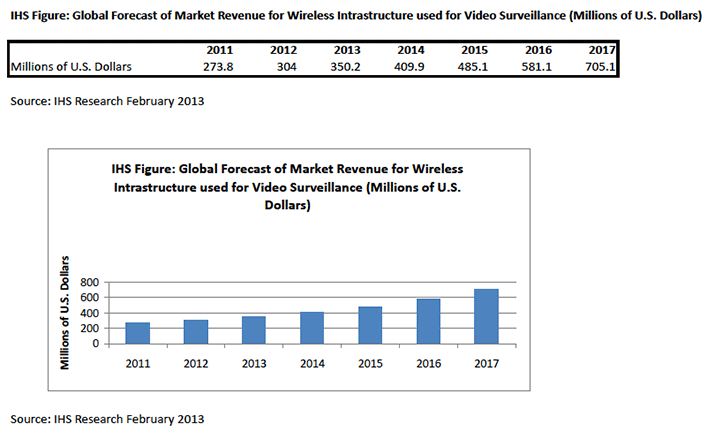
Wireless Infrastructure Market Set to More than Double by 2016
The global market for wireless infrastructure gear used for video surveillance applications is set to more than double from 2011 to 2016, with a significant amount of growth driven by demand for low-cost systems in emerging economies, like China and India. Worldwide revenue for such equipment will soar to $705 million in 2017, up nearly 160 percent from $274 million in 2011, according to a new report published by IMS Research, now part of IHS Inc. After increasing by 11 percent in 2012, growth will accelerate to 15 percent in 2013, with revenue reaching $350 million.

“Offering a relatively inexpensive solution compared to trenching cable, wireless infrastructure delivers a low-cost option for those who that want to establish surveillance networks,” said Josh Woodhouse, video surveillance analyst at IHS. “In regions with widespread existing video surveillance infrastructure, such as the United States or the United Kingdom, the adoption of wireless infrastructure for video surveillance is growing steadily. However, emerging regions that lack such infrastructure will generate the strongest growth in the world, causing the market for video surveillance wireless infrastructure gear to boom during the coming years.”
Keeping an eye on video surveillance in different regions
The global market for wireless infrastructure gear for video surveillance is expected to expand at a compound annual growth rate (CAGR) of 17 percent from 2011 through 2017. Global growth will be led by China, with a stunning 28.8 percent revenue CAGR during the period. The next fastest-growing region will be the rest of the Asia region—an area including India—that will increase by 27.9 percent. Mexico is set for a 23.1 percent CAGR, Brazil will rise by 17.4 percent, and the rest of South America will increase by 26.6 percent.
Asia goes for wireless surveillance
The Asian market is currently the smallest and least developed region for wireless infrastructure gear for video surveillance. However, Asia is forecasted to grow the fastest among all global areas in the coming years thanks to the region’s lack of any existing wired surveillance infrastructure, combined with the low cost of wireless and the booming demand for security.
Cisco leads the market
Cisco Systems Inc. was the leading supplier of wireless infrastructure gear used in video surveillance in 2012, with an 11.7 percent share of global market revenue.